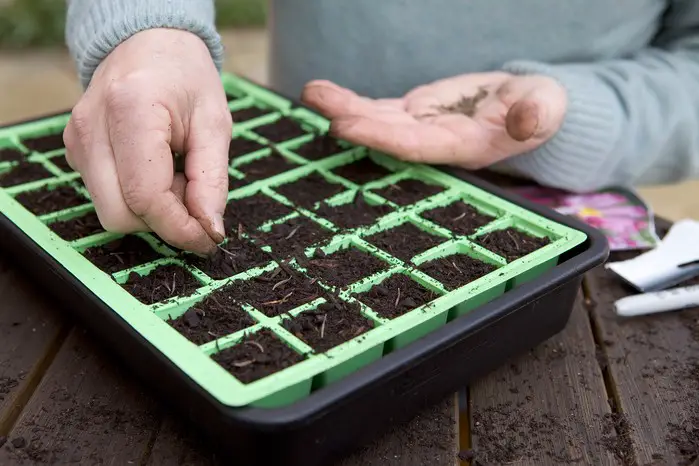Few flowers bring as much effortless beauty to a garden as cosmos. With their delicate petals, airy foliage, and vivid colors, they seem to dance in every breeze. Yet the secret behind a garden filled with cosmos from spring through fall lies in timing. Knowing when to sow cosmos can make the difference between a short burst of blooms and a long, colorful display that lasts until the first frost. These flowers reward good timing with months of vibrant blossoms that fill borders, beds, and containers with charm.
Cosmos are forgiving plants that thrive in many conditions, but they bloom longest when sown at just the right time. Whether you start them indoors for an early show or sow them directly outdoors for natural growth, understanding your local climate is key. Proper sowing timing allows the plants to establish before summer heat and keep producing new flowers into autumn. In this guide, you’ll learn when to sow cosmos for a continuous bloom, how to stagger plantings for extended color, and the best methods for early and late sowing success.
Understanding the Growth Cycle of Cosmos

To know when to sow cosmos for continuous blooming, it’s important to first understand their natural growth cycle. Cosmos are warm-season annuals, which means they complete their entire life—from germination to flowering and seed production—within a single growing season. Their growth is highly influenced by temperature and daylight. Once the soil warms and frost danger has passed, cosmos seeds germinate quickly, usually within a week. The seedlings grow fast, producing fine, feathery leaves before developing tall, sturdy stems. Within six to eight weeks after sowing, the first flower buds begin to appear, signaling the start of their blooming phase.
The flowering stage is the most rewarding part of the cosmos life cycle. During this time, the plants continuously produce new blossoms while older flowers fade. Regular deadheading encourages the plant to keep producing buds instead of setting seeds. In ideal conditions, this blooming period can last from early summer all the way until frost arrives. Once temperatures drop significantly, the plant begins to slow down and eventually completes its life cycle. However, with careful timing and staggered sowing, you can ensure overlapping generations of cosmos, creating a seamless wave of flowers that never stops blooming.
Cosmos are photoperiod-sensitive, meaning their flowering is partly regulated by the length of daylight. As summer progresses and days begin to shorten, the plants respond by accelerating their blooming. Understanding this natural rhythm helps gardeners plan sowing times effectively. By aligning planting schedules with your region’s climate and daylight patterns, you can achieve a garden that stays alive with color from the gentle warmth of spring until the cool touch of autumn.
The Best Time to Sow Cosmos Seeds (By Climate Zone)
Zone 3–5: Late Spring Sowing
In colder climates, such as USDA Zones 3 to 5, cosmos should be sown after the danger of frost has fully passed. The soil needs to warm to at least 60°F (16°C) before seeds can germinate successfully. For these regions, this usually means sowing cosmos outdoors in late May or early June. Starting seeds indoors four to six weeks before the last frost can give plants a head start, allowing them to bloom earlier in summer. Once seedlings are established outdoors, they will continue flowering through September, provided they receive full sunlight and moderate moisture.
Because these zones have shorter growing seasons, succession sowing becomes especially useful. By planting a second batch of seeds two to three weeks after the first, gardeners can extend the bloom well into early fall. Protecting late-season plants from unexpected cold snaps with row covers helps them thrive longer. When managed carefully, even gardeners in northern regions can enjoy a rich display of cosmos that lasts from midsummer until the first frost touches the petals.
Zone 6–8: Mid-Spring to Early Summer
In USDA Zones 6 to 8, cosmos can be sown much earlier, as these regions experience longer and warmer growing seasons. The best time to sow outdoors is typically from mid-April to late May when soil temperatures are consistently warm. Gardeners who prefer earlier blooms can start seeds indoors in March, transplanting seedlings outdoors once nighttime temperatures stay above 50°F (10°C). Cosmos adapt quickly to outdoor conditions in these zones and will start flowering by early June.
For continuous color, a second sowing in late May or early June ensures new waves of blooms that last into autumn. Because the warm climate allows rapid growth, cosmos thrive with minimal care once established. Avoid over-fertilizing, as this can encourage excessive foliage instead of flowers. With proper spacing, full sun, and regular deadheading, cosmos in Zones 6 to 8 can bloom steadily from early summer through the first light frosts of October or November, keeping gardens radiant for months.
Zone 9–10: Early Spring and Fall Sowing
In warmer climates such as USDA Zones 9 and 10, cosmos enjoy extended growing seasons that allow two distinct sowing periods—early spring and late summer. Gardeners in these zones can sow seeds as early as February or March for spring and early summer blooms. When daytime temperatures reach around 70°F (21°C), the soil becomes ideal for germination. Since extreme summer heat can shorten the blooming period, it’s best to provide some afternoon shade or sow again in late August or early September for a fall flush of flowers.
This dual sowing approach gives southern gardeners two long waves of cosmos blooms—one before the hottest part of summer and another leading into late autumn. Fall-sown cosmos often bloom more vividly because of cooler nights and moderate days. Regular watering, well-drained soil, and consistent deadheading keep the plants blooming until winter temperatures finally drop. With careful scheduling, Zones 9 and 10 can enjoy cosmos nearly year-round, transforming gardens into continuous displays of color and movement.
Indoor vs. Outdoor Sowing: Which Method Works Best?
Choosing between indoor and outdoor sowing depends largely on your climate, growing season length, and gardening goals. Both methods can produce stunning cosmos blooms, but each offers unique advantages. Indoor sowing is ideal for gardeners in cooler regions or areas with unpredictable spring weather. Starting seeds indoors four to six weeks before the last frost ensures earlier germination and stronger seedlings ready for transplanting once the soil warms. This approach also protects young plants from pests, heavy rain, or late frosts that can easily damage tender sprouts. Indoor-grown cosmos often bloom several weeks earlier than those sown directly outdoors, giving you a longer flowering season overall.
Outdoor sowing, on the other hand, is simpler and more natural. Cosmos are hardy, fast-growing flowers that adapt well when sown directly into the soil once frost risk has passed. Seeds germinate quickly in warm soil and develop stronger roots because they are never disturbed by transplanting. Direct sowing is also less labor-intensive, making it perfect for larger flower beds or wild-style gardens. However, timing is crucial—sowing too early can expose seeds to cold soil, slowing germination or causing rot. For best results, many gardeners combine both methods: start some seeds indoors for early blooms and sow another batch outdoors later for continuous color.
Ultimately, the best method depends on your location and preferences. If you want a head start and precise control, indoor sowing gives predictable results. If you prefer a hands-off approach and enjoy natural growth, direct outdoor sowing is ideal. Blending the two ensures a seamless display of cosmos blooms that begins in early summer and continues well into fall, creating a garden that never stops flowering.
How to Stagger Sowing for Continuous Blooms
Staggering your sowing schedule is the secret to achieving a cosmos display that lasts from the first warmth of spring to the final touch of frost. Rather than planting all your seeds at once, divide them into several batches and sow at intervals of two to three weeks. This simple method ensures that as one group of cosmos reaches its peak bloom, another is just beginning to flower. The result is a seamless transition of color and life across your garden, with no gaps between flowering cycles. For gardeners in cooler regions, the first batch can start indoors, while later rounds can be sown directly outdoors once temperatures rise.
Each successive sowing rejuvenates your garden with fresh plants, keeping the display lush and dynamic. Early sowings bloom in late spring and early summer, while midseason plantings take over through the hottest months. The final batch, usually sown in midsummer, ensures blooms that continue glowing into autumn. As older plants begin to fade, the newer ones take center stage, maintaining constant beauty. Deadheading faded flowers throughout the season further extends bloom life by redirecting the plant’s energy into bud production instead of seed formation.
Staggered sowing also gives gardeners flexibility in experimenting with different cosmos varieties, such as tall, airy types or compact, bushy ones. Mixing heights and bloom times adds texture and rhythm to your garden’s design. This approach works beautifully in beds, borders, and containers, allowing a continuous succession of flowers that appear effortless. With just a bit of planning, your cosmos will keep blooming joyfully from spring until the first frost, offering endless waves of delicate color and motion that embody the essence of summer gardening.
Soil and Sunlight Requirements for Optimal Growth
Soil Conditions for Cosmos
Cosmos are among the most forgiving flowers when it comes to soil quality, yet providing the right foundation ensures longer-lasting blooms and stronger growth. They thrive best in light, well-draining soil with moderate fertility. Overly rich soil may sound ideal, but it often produces more foliage than flowers, reducing bloom production. A sandy or loamy soil with a slightly acidic to neutral pH between 6.0 and 7.0 is perfect. Before sowing, loosen the soil to improve aeration and drainage, which allows roots to spread easily. If your soil is heavy or clay-based, mix in compost or coarse sand to improve structure and prevent waterlogging.
Cosmos are drought-tolerant once established, but seedlings still need consistent moisture for proper root development. Water the soil lightly before sowing and keep it evenly moist until germination occurs. Avoid compacting the surface, as this limits oxygen flow to young roots. Adding a thin layer of mulch after seedlings appear helps retain moisture and regulate soil temperature. Good soil preparation at the start ensures your cosmos not only germinate quickly but also maintain strong stems and abundant blooms throughout the growing season.
Sunlight and Temperature
Sunlight is one of the most crucial factors for cosmos growth and flowering. These plants crave full sun—at least six to eight hours of direct light per day—to reach their full potential. In shadier spots, they may grow tall and weak with fewer flowers. The intensity of sunlight drives the plant’s energy toward bud formation, leading to continuous waves of blooms. For indoor seedlings, placing them near a bright window or under grow lights replicates the full-sun conditions they need to thrive. In outdoor gardens, choose open spaces free from shade cast by trees or buildings.
Temperature also plays an important role in both germination and bloom performance. Cosmos prefer warm weather and grow best between 70°F and 85°F (21°C–29°C). They tolerate mild heat well but slow down if temperatures remain above 95°F (35°C). In cooler climates, warmth from the soil and air stimulates faster growth and earlier flowering. As autumn approaches, cooler nights enhance flower color intensity, making late-season blooms especially vivid. By combining proper sunlight and temperature management, you give your cosmos the ideal environment for vibrant, long-lasting blooms from spring to frost.
Watering and Feeding Schedule for Continuous Blooms
Watering the Right Way
Cosmos thrive in moderately dry conditions, but understanding when and how to water makes all the difference for continuous flowering. During germination and early growth, the soil should stay evenly moist to help roots establish. Once mature, cosmos become drought-tolerant and only need watering when the top inch of soil feels dry. Deep, infrequent watering promotes strong roots that can access deeper moisture, making plants more resilient during hot or windy weather. Shallow, frequent watering weakens the roots and increases the risk of stress during dry spells.
It’s best to water early in the morning so the soil absorbs moisture before temperatures rise. Avoid wetting the leaves and flowers to prevent fungal diseases. If growing cosmos in containers, check moisture levels daily, as potted soil dries faster than garden beds. During rainy periods, ensure proper drainage to prevent root rot. Mulching around the base of plants helps conserve moisture while keeping weeds at bay. Proper watering keeps the soil balanced—moist enough to sustain growth but never so wet that roots suffocate, ensuring cosmos continue to bloom happily all season long.
Feeding for Strong and Steady Blooms
Cosmos are light feeders, and too much fertilizer can reduce their flowering potential. These plants thrive best in moderately fertile soil, where they must work a little to find nutrients. Overfeeding, especially with nitrogen-rich fertilizers, encourages leafy growth at the expense of blooms. For consistent flowering, use a balanced or low-nitrogen fertilizer every four to six weeks during the growing season. A formula like 5-10-10 helps promote root strength and abundant flowers without overstimulating foliage.
Organic options like compost or worm castings provide slow, steady nourishment and improve soil texture. Applying compost as a midseason top dressing gives the plants a gentle nutrient boost, keeping them healthy without risk of overfeeding. After fertilizing, water lightly to help nutrients absorb into the soil. Avoid feeding in extreme heat, as it can stress the plant. By maintaining a careful feeding routine—light, regular, and balanced—you’ll keep your cosmos strong, vibrant, and capable of producing waves of blossoms from the first warmth of spring to the chill of autumn.
Deadheading and Pruning to Extend the Bloom Season
The Importance of Deadheading
Deadheading is one of the simplest yet most effective ways to keep cosmos blooming from spring to frost. When flowers fade and are left on the plant, cosmos naturally begin to form seeds, signaling that their reproductive cycle is complete. This shift in energy slows or stops the production of new flowers. By regularly removing spent blooms, you prevent seed formation and encourage the plant to continue producing fresh buds. The process keeps the cosmos in a constant state of renewal, leading to fuller, longer-lasting displays of color.
To deadhead properly, use clean scissors or your fingers to snip off the faded bloom just above the first pair of healthy leaves or side branches. This not only improves appearance but also stimulates lateral growth, creating more branching and, consequently, more blooms. Inspect your plants every few days during peak flowering season. Consistent deadheading maintains momentum in blooming and extends the life of your plants well into late autumn. It’s a small habit that yields massive rewards—turning a single wave of flowers into a continuous, season-long spectacle.
Light Pruning for Healthier Growth
Pruning cosmos goes beyond removing old flowers—it’s also essential for keeping the plant balanced, strong, and productive. As the season progresses, cosmos can grow tall and leggy, especially in rich soil or shaded spots. Light pruning helps control their shape, prevents top-heaviness, and promotes bushier, sturdier growth. The best time to prune is early in the season when plants reach about one foot tall. Pinch or cut back the top inch of each main stem to encourage branching. This simple act triggers the growth of multiple side shoots, which later produce even more flowers.
Midseason pruning is equally beneficial. Cutting back tall or fading stems by one-third rejuvenates the plant, stimulating new growth and prolonging the bloom period. After pruning, water the plants well and, if needed, feed them lightly to support recovery. Avoid heavy trimming late in the season, as this can reduce flowering. Instead, focus on light maintenance cuts to keep the plant tidy and vibrant. Combining gentle pruning with regular deadheading ensures your cosmos remain healthy, balanced, and full of flowers that continue blooming joyfully until frost.
Common Sowing Mistakes That Affect Bloom Continuity
Sowing Too Early or Too Late
Timing is everything when it comes to sowing cosmos seeds. Planting too early, while frost is still possible, can expose young seedlings to cold stress and slow growth. Even if the seeds germinate, the fragile plants may struggle in cold, wet soil. On the other hand, sowing too late in the season reduces bloom time, as cosmos need at least two months of warm weather to mature and flower fully. In regions with short summers, late sowing can result in fewer blooms before frost arrives.
To achieve a long, continuous bloom, wait until the soil has warmed to at least 60°F (16°C) before sowing. In cooler zones, start seeds indoors to gain several weeks of growth before transplanting. For warmer climates, sow in early spring or again in late summer to extend the flowering period. Getting the timing right allows cosmos to grow at their natural rhythm, producing a steady progression of blooms that lasts through the entire warm season.
Overcrowding the Seeds
Another common mistake is sowing cosmos seeds too close together. Because cosmos are vigorous growers, crowded seedlings compete for light, air, and nutrients, which leads to weak, spindly plants and fewer flowers. Poor air circulation also increases the risk of fungal diseases, especially in humid climates. Without enough space, plants stretch upward instead of branching outward, resulting in fewer blooms and an uneven display.
To prevent this, always thin seedlings once they reach a few inches tall, leaving 12 to 18 inches of space between smaller varieties and up to 24 inches for taller types. This spacing encourages airflow and allows each plant to receive enough sunlight. Properly spaced cosmos produce fuller plants with stronger stems and longer blooming periods. Adequate room also simplifies watering, feeding, and deadheading, ensuring every plant thrives and contributes to a lush, continuous garden display.
Ignoring Soil and Light Conditions
Even though cosmos are low-maintenance, neglecting their basic soil and light requirements can disrupt the blooming cycle. Sowing seeds in rich, nitrogen-heavy soil promotes rapid leafy growth instead of flower production. Similarly, planting cosmos in shaded areas drastically reduces their ability to bloom. Without at least six hours of direct sunlight daily, plants become leggy and produce fewer, smaller blossoms. Soil that stays soggy or compacted can also hinder root health and cause slow, uneven growth.
To maintain continuous flowering, plant cosmos in full sun and well-draining, moderately fertile soil. Avoid adding too much fertilizer before or after sowing. The ideal soil texture should feel loose and crumbly, allowing roots to expand easily. When sunlight, moisture, and soil conditions are well-balanced, cosmos grow stronger, bloom longer, and recover quickly after each flowering cycle. By correcting these common mistakes, you can enjoy a garden that bursts with vibrant color from the first days of spring to the cool breath of autumn.
FAQs About Sowing and Blooming Cosmos
When is the best time to sow cosmos seeds?
The best time to sow cosmos depends on your climate. In most regions, sow seeds outdoors after the last frost when soil temperatures reach 60°F (16°C). Gardeners in cooler zones can start seeds indoors four to six weeks early, while warm climates may allow both spring and late-summer sowings.
How long do cosmos take to bloom after sowing?
Cosmos usually take between seven and ten weeks from sowing to their first blooms. Starting seeds indoors gives them a head start, resulting in earlier flowering. With staggered sowing every few weeks, you can enjoy continuous color from early summer until the first frost.
Should I start cosmos indoors or sow directly outdoors?
Both methods work well, but indoor sowing provides a longer blooming period. Starting seeds indoors protects them from frost and ensures earlier growth. Direct sowing, however, is easier and produces naturally hardy plants. Many gardeners combine both methods for non-stop blooms.
How do I keep cosmos blooming continuously?
Regular deadheading is the key to prolonged blooming. Remove faded flowers to prevent seed formation and encourage new buds. Combine this with moderate watering, full sunlight, and light feeding. Staggered sowing every few weeks ensures overlapping bloom cycles that last from spring to frost.
Why aren’t my cosmos blooming?
If your cosmos have lush foliage but few flowers, the soil may be too rich in nitrogen or the plants may not receive enough sunlight. Ensure they get at least six hours of direct sun daily. Avoid over-fertilizing, and keep soil slightly lean to promote abundant, long-lasting blooms.
Conclusion
Knowing when to sow cosmos is the key to unlocking a season full of color, grace, and effortless beauty. With the right timing, proper soil, and consistent care, these flowers reward every gardener with months of continuous blooms. From early spring sowings to late-summer successions, cosmos can brighten your garden until the first frost. Their resilience, simplicity, and endless charm make them perfect for any space. By mastering sowing schedules and a few mindful habits, you can create a garden that blooms in harmony with the seasons—vibrant, ever-changing, and filled with the joyful spirit of cosmos.






